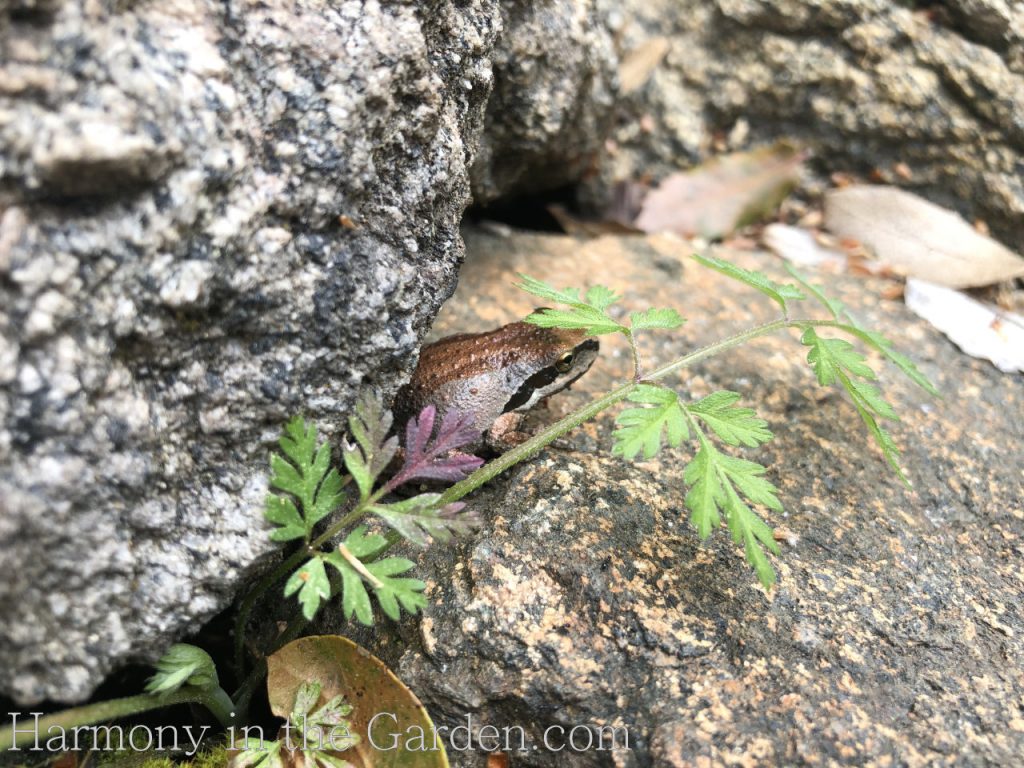
It’s been pouring rain for days now, which is the perfect time to talk about creating a rain garden.
Even though many plants are still deciduous, patiently waiting for warmer weather, there’s still plenty happening right now to talk about its late winter-early spring charms.
Besides, if you’re like me, I love taking a peek at gardens that are still works-in-progress.
But for now, I hope you enjoy seeing what my late winter garden looks like, and my thought process behind its creation.

When we moved here a few years ago, this was the most depressing part of the garden, which meant I had to address it ASAP.
Especially since I see it every time I drive up my driveway or walk into the front yard.
This poor dead oak tree never stood a chance, surrounded by water-guzzling lawn.
The space is in full sun throughout most of the day (with summer temperatures regularly reaching 100+ degrees) and is wide open to the deer who like to visit.

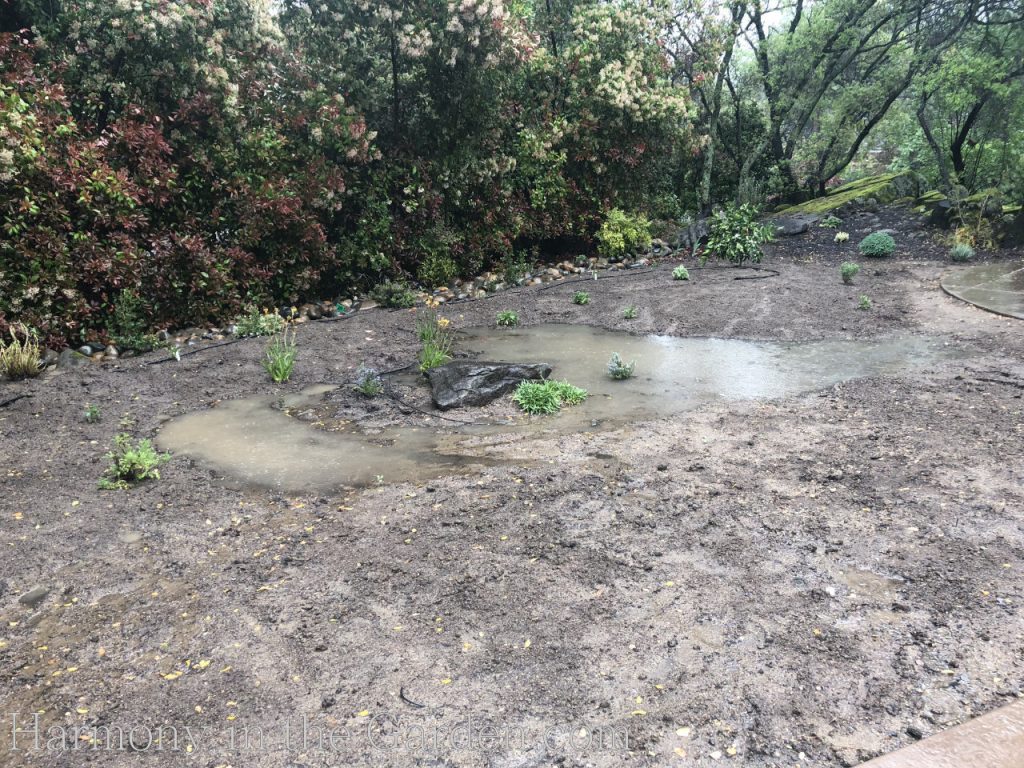
My entire front garden gently slopes downwards towards the street.
But this particular area has a naturally occurring ‘valley’ of sorts, with a low point in the center.
When it rains, the water runs down my long driveway, right through the middle of this valley and into the neighboring driveway, then straight down to the street where it’s wasted.
When tackling a difficult area like this, I find it helpful to create a list of objectives, as well as problems that need to be solved.
It’s a great method for narrowing down priorities.
Objective #1
Capture every last drop of water & keep it on my property
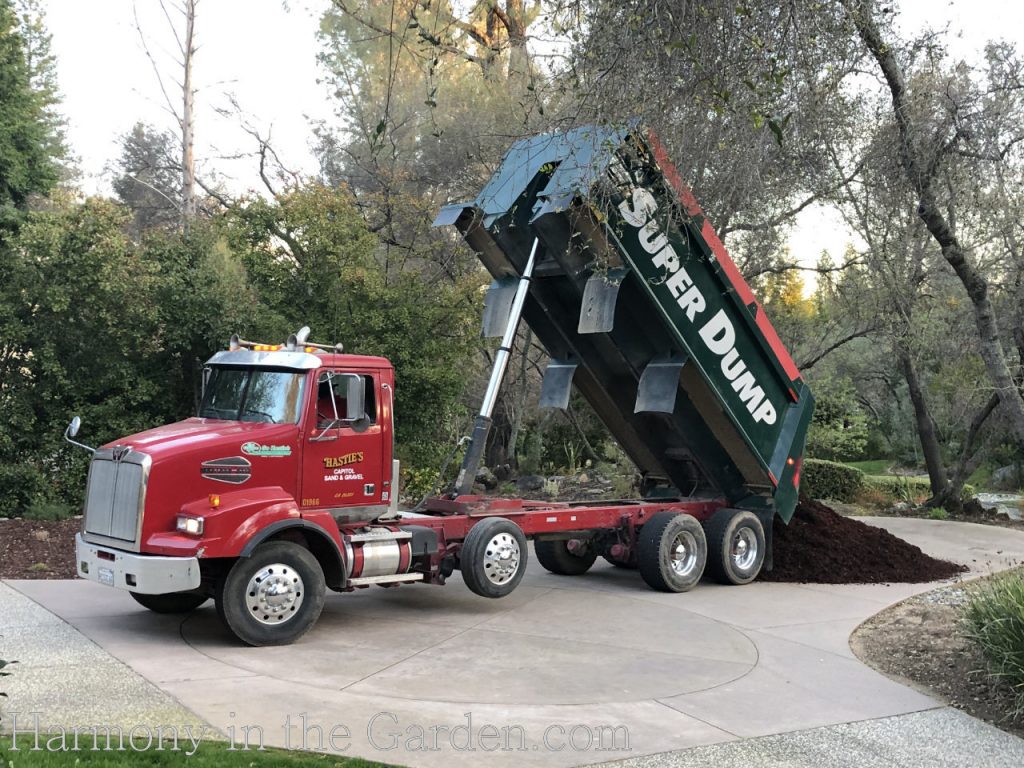
After removing the dead lawn, half dead shrubs and the dead oak tree, I now had a lovely, blank slate.
Oh, how I love blank slates – it’s so much easier to be creative once the mess is removed!
The first step was to mix in LOTS and LOTS of fast-draining compost to the existing nutrient-poor clayish soil.
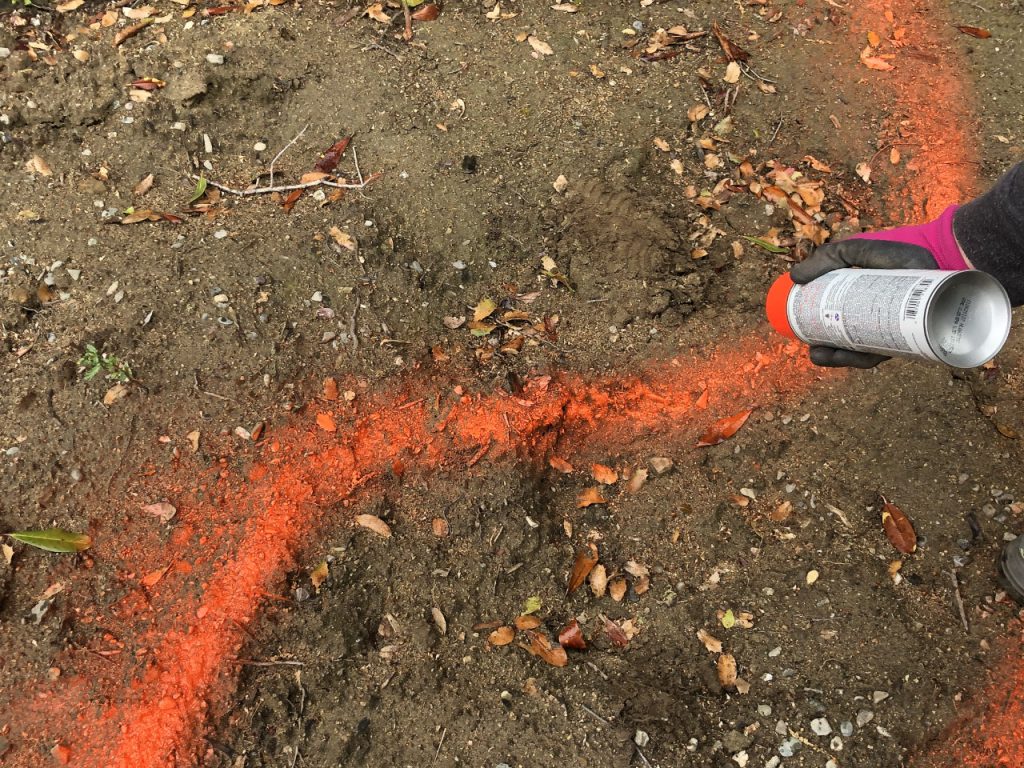
I then created a crescent-shaped berm high enough to contain the winter rain that would run-off from the driveway and prevent it from spilling into my neighbor’s property.
I like to use landscape paint when creating the shape and size of a future garden bed.
The paint is inexpensive, sprays while being held upside down, and is easy to wipe away with your foot if you need to start over.
It also remains visible for several days, if needed, as long as it doesn’t rain.
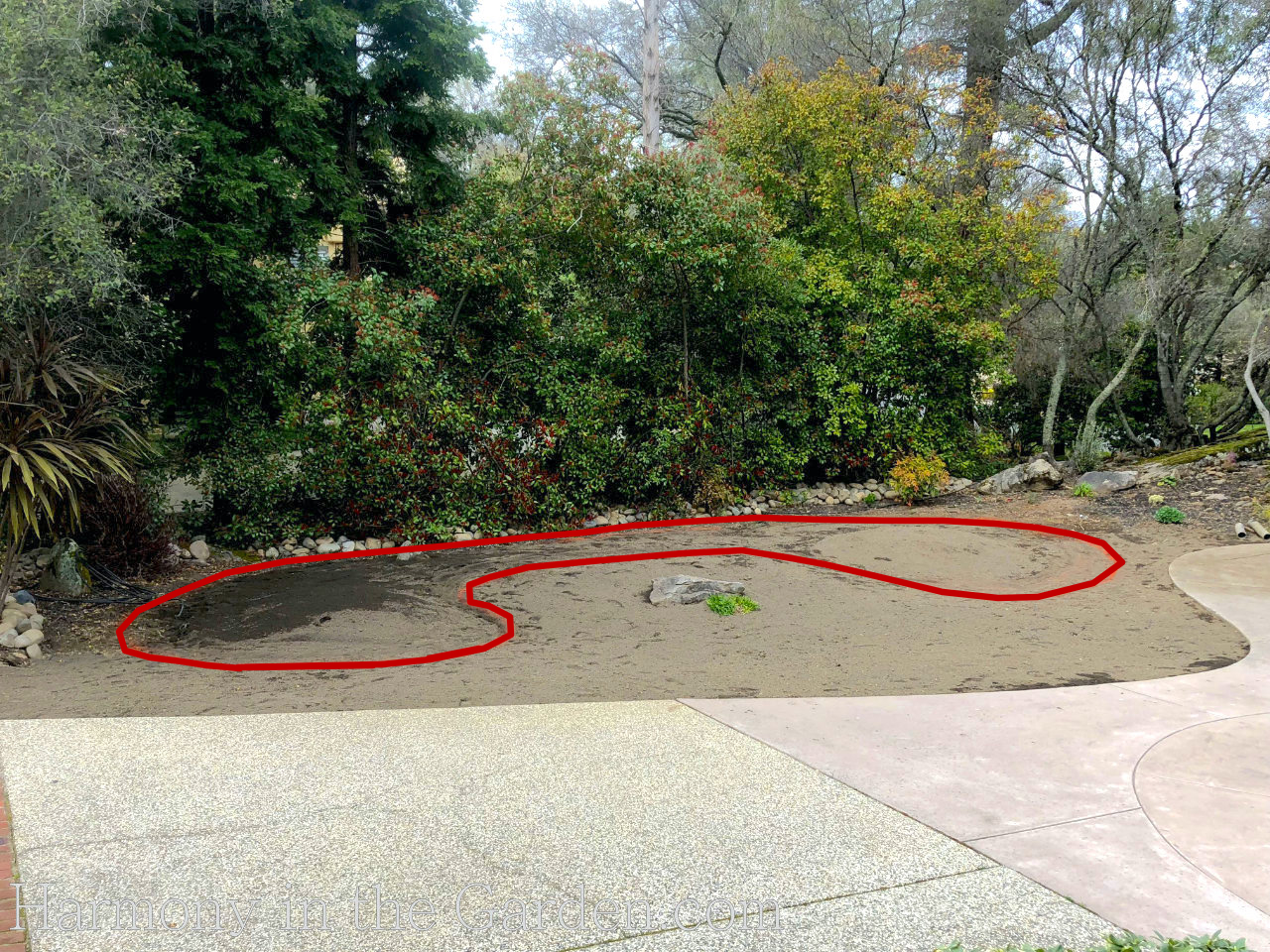
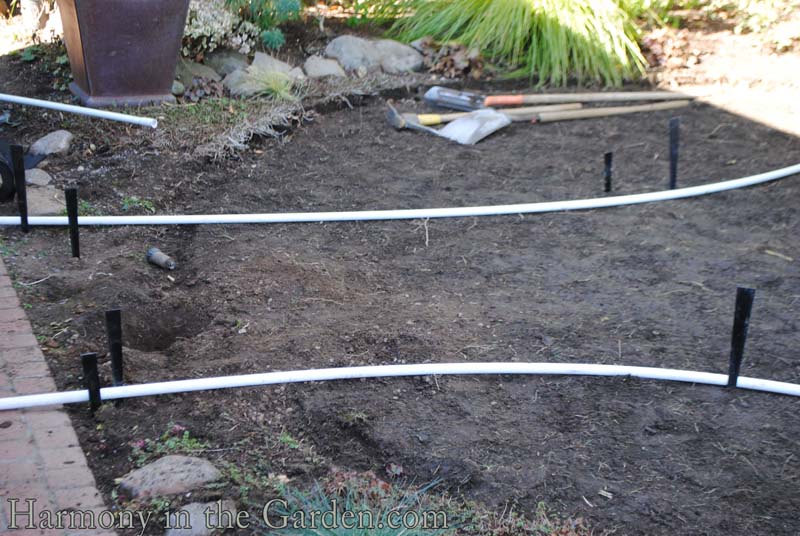
While there are other methods people use to mark out a bed’s shape (ie: using a rope, garden hose, or even sprinkling flour), I find they’re not as effective in creating smooth lines and curves.
One exception, though, is using long pieces of PVC pipe – click here for more pics demonstrating this method.
For my rain garden, however, using landscape paint was more convenient for me.
Objective #2
Choose adaptable plants that can thrive in very wet and very dry soil (not as easy as you might think!)
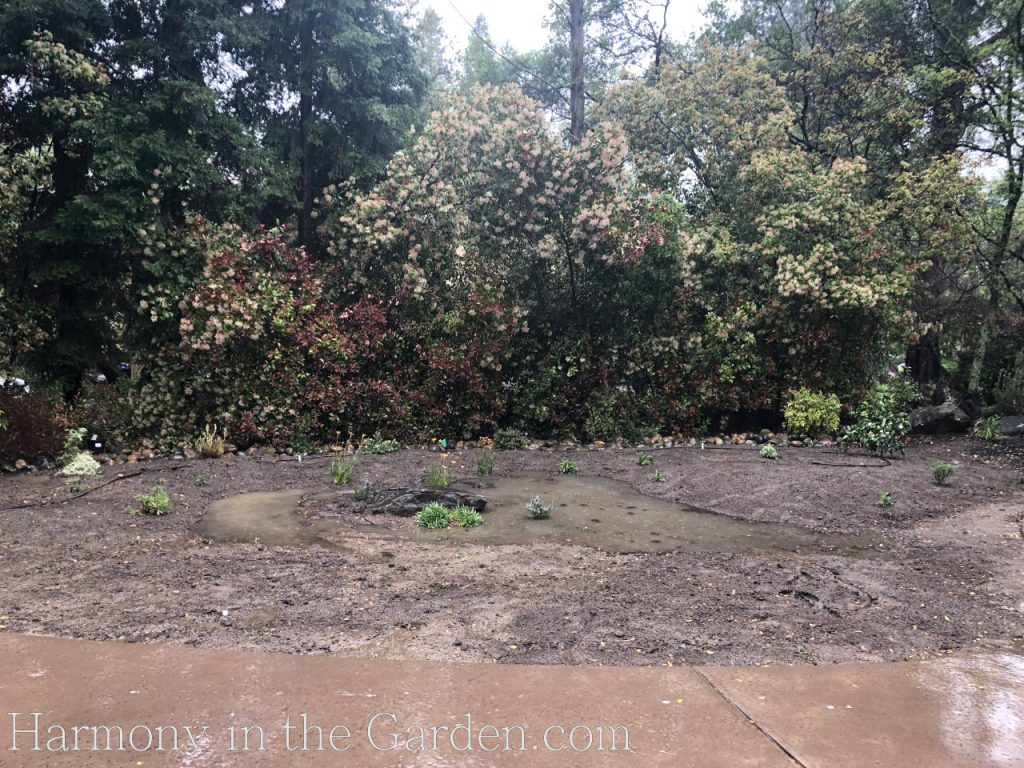
Another challenge I faced when creating this rain garden, was to find plants that would thrive at the very ‘bottom of the bowl.’
Why?
Because the plants at the lowest part of the depression would need to be happy with ‘wet feet’ in the winter (sometimes sitting in a puddle of water for a many days at a time.)
And here’s where it gets tricky – these same plants ALSO need to be happy with limited water the rest of the year.
Here’s a few varieties that have done really well:
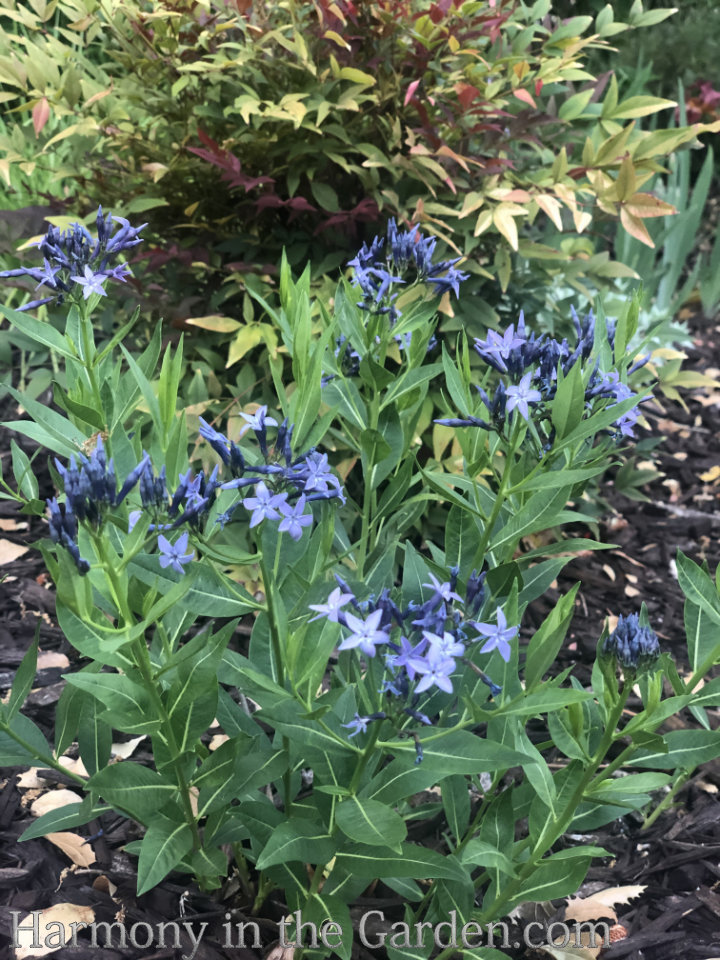
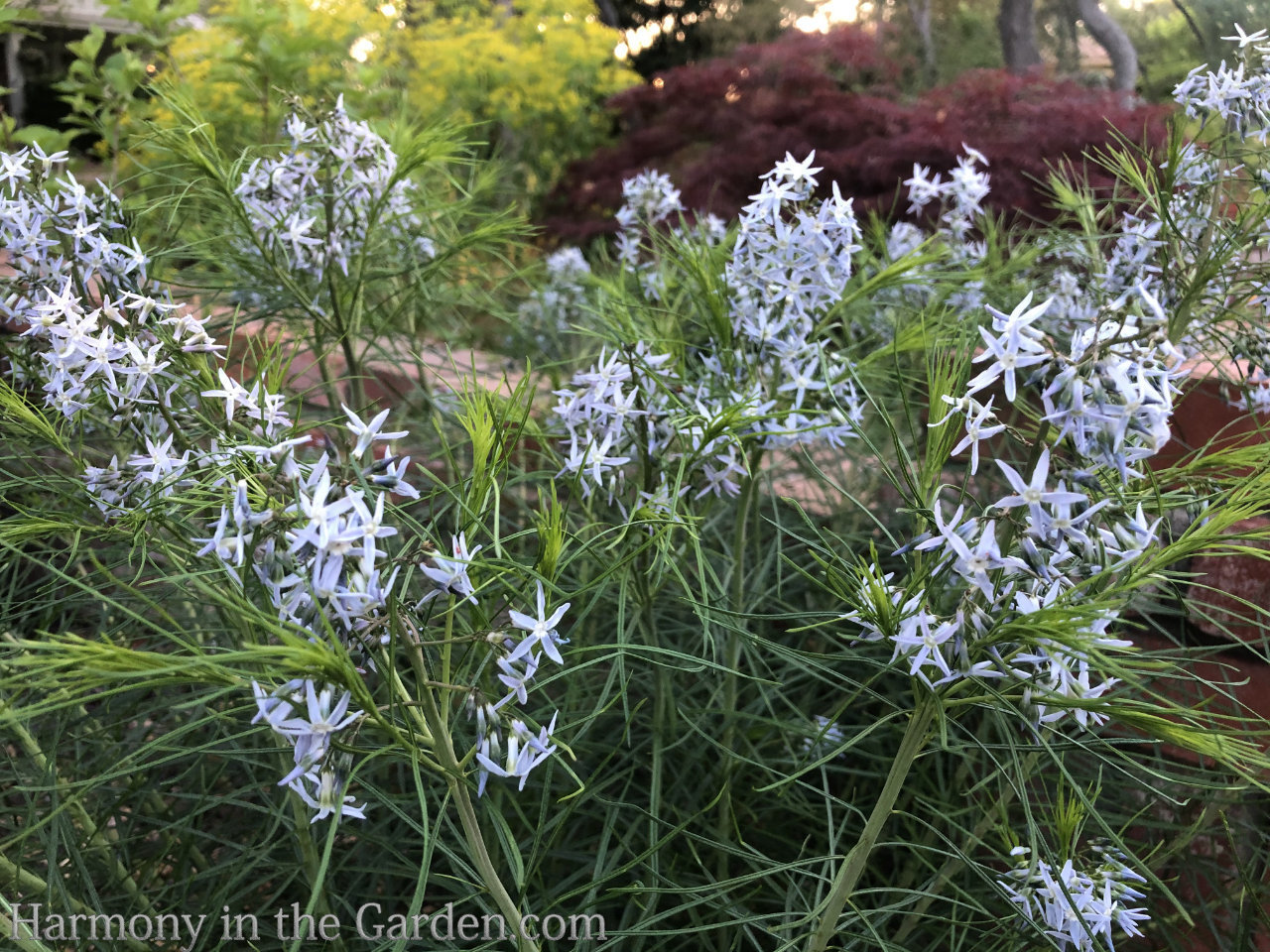
I’ve had fantastic luck with two types of Bluestar – amsonia ‘Blue Ice’ (left) and amsonia hubrichtii (above.)
In fact, if you’d like to see some pretty amazing photos of how incredible this variety has done in my front entry garden, click here.
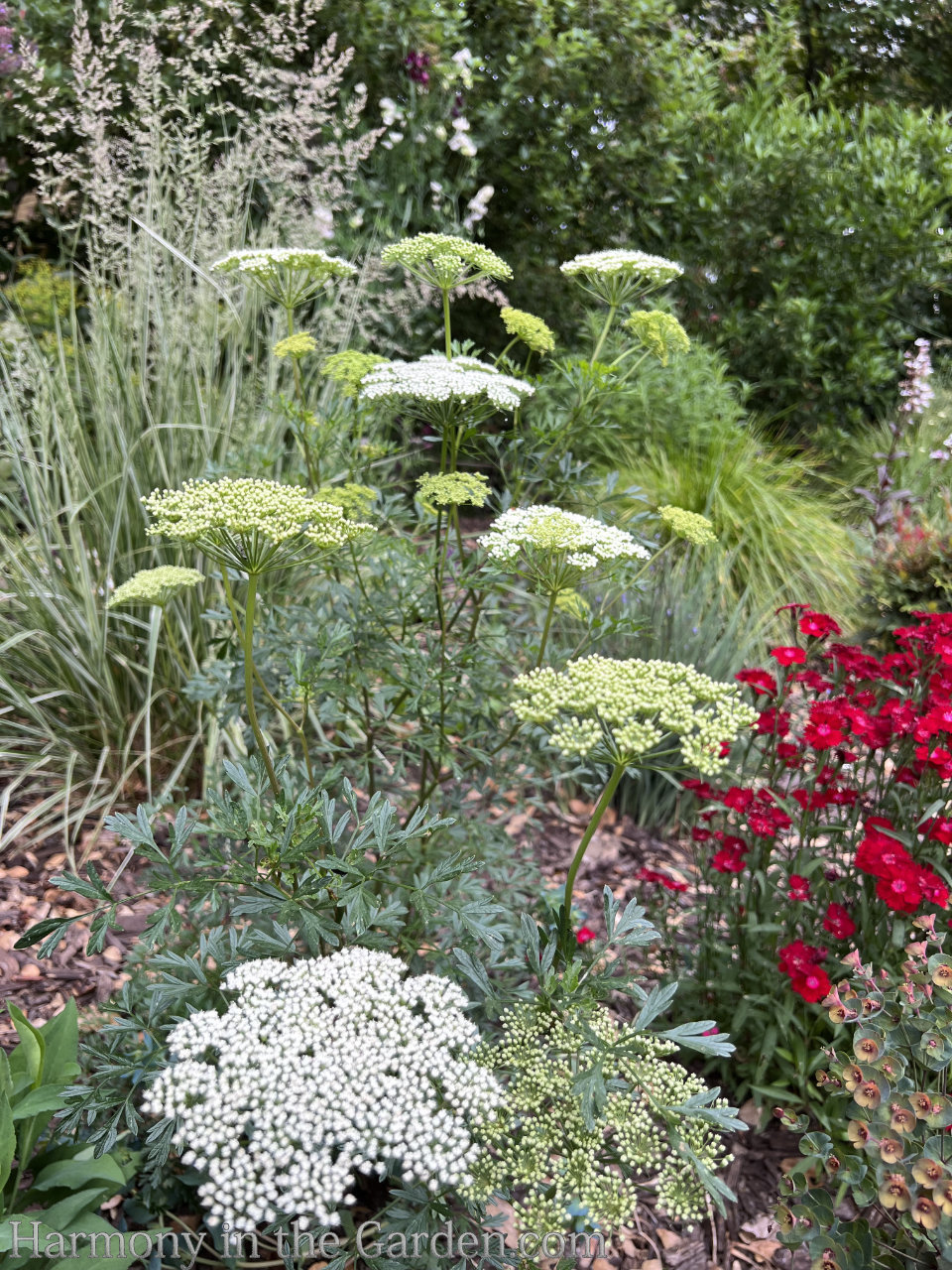
Cenolophium denudatum (Baltic Parsley) is another perennial that has done really well with wet feet in the winter and dry in the summer.
I ordered it through Annie’s Annuals, and while it took a few years to get established, it really took off after year three.
The oversized, white flowers appear to float through the spring garden, and last for months at a time, slowly fading to a lovely soft tan color.
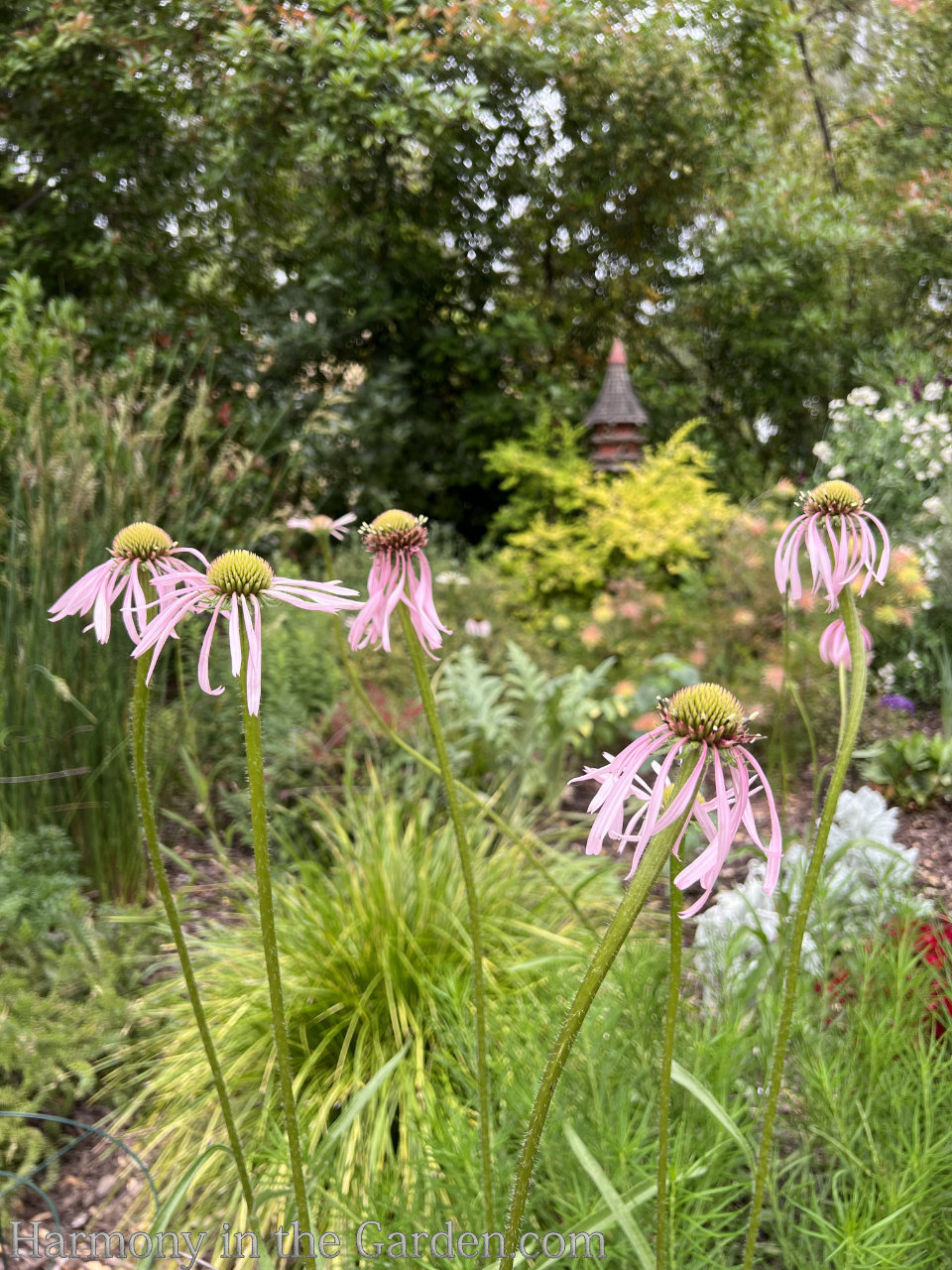
This native variety of coneflower, echinacea pallida does really well with wet feet in the winter, and dry feet throughout the rest of the year.
I especially love the seed heads which remain on the plant throughout winter, providing much-needed winter interest.
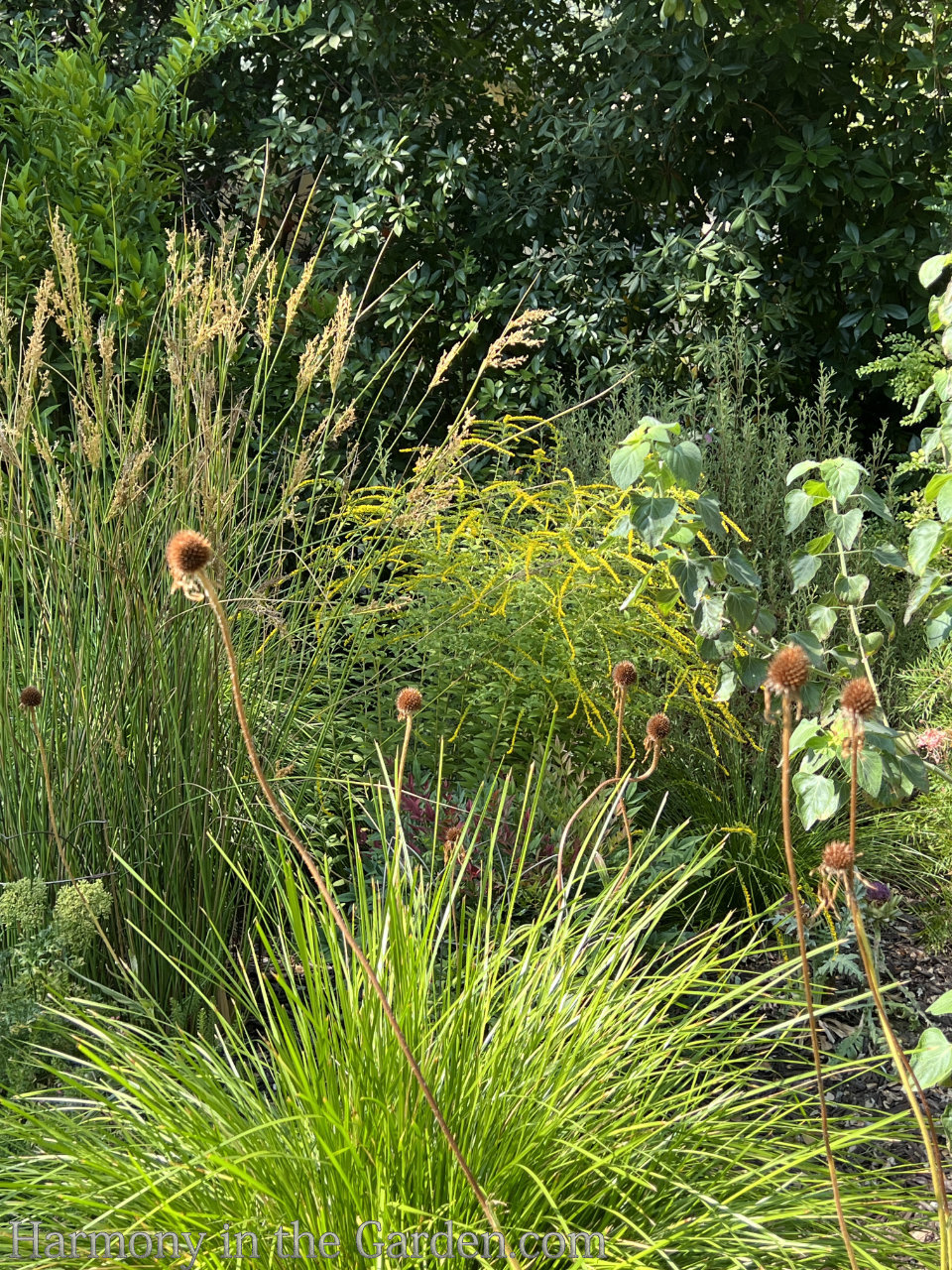
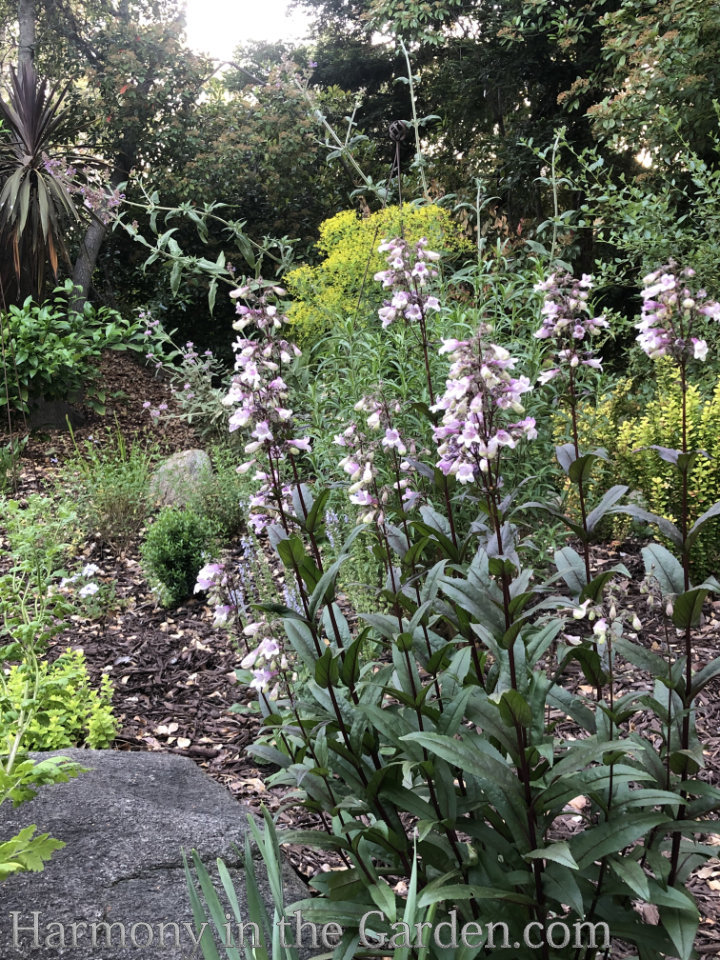
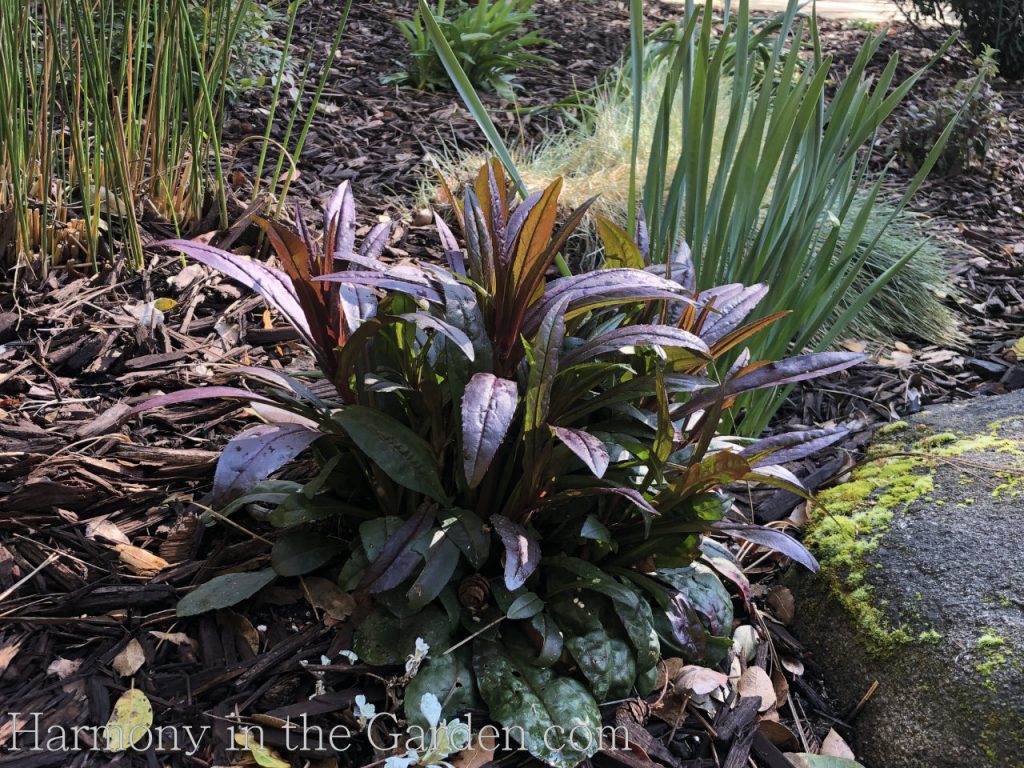
Penstemon ‘Midnight Masquerade’ is another of my favorites that has done incredibly well living in the flood-zone/dry-zone.
I’ve also found this variety to be one of the few maroon penstemons that retain much of its moody dark colors throughout the summer heat.
Other maroon penstemons tend to lose their colors in the heat of summer, and turn olive green.
Also, in mild-climate winters like mine, it never goes truly dormant, but remains above ground, forming subtle maroon-colored mounds.
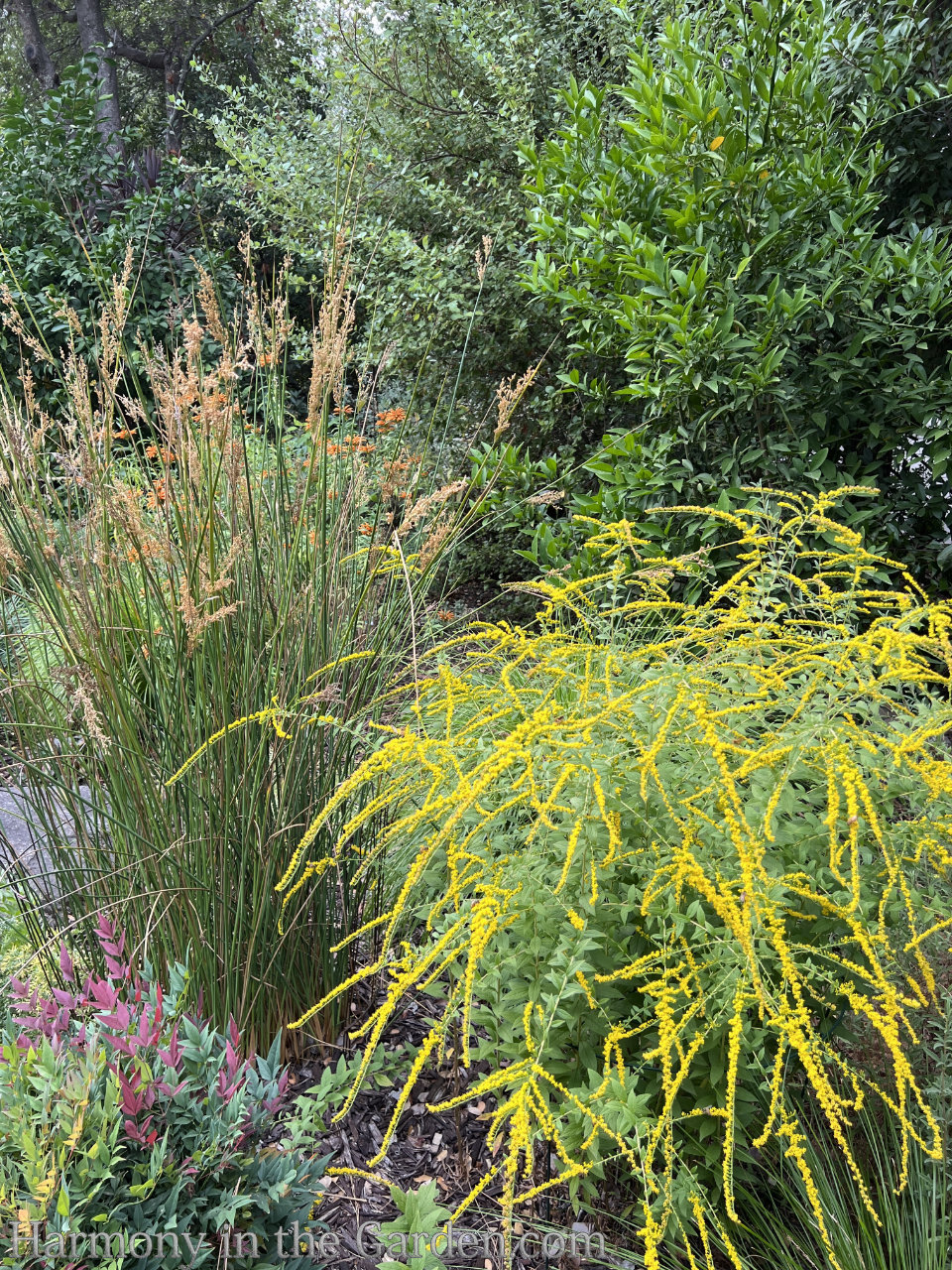
The tall grass-like plant on the left is a juncus ‘Javelin’, which has done incredibly well in this area.
It’s an evergreen plant, which looks great year-round, even in the dead of winter.
But it’s especially lovely when blooming alongside the yellow fall flowers of neighboring solidago ‘Fireworks.’
Other plants that have thrived in this difficult spot are Feverfew (chrysanthemum aureum), Switchgrass (panicum virgatum ‘Apache Rose,’ and Feather Reed Grass (calamagrostis acutifolia ‘Overdam’.)
Objective #3
Provide year-round interest with seasonal color echoes and evergreen plants
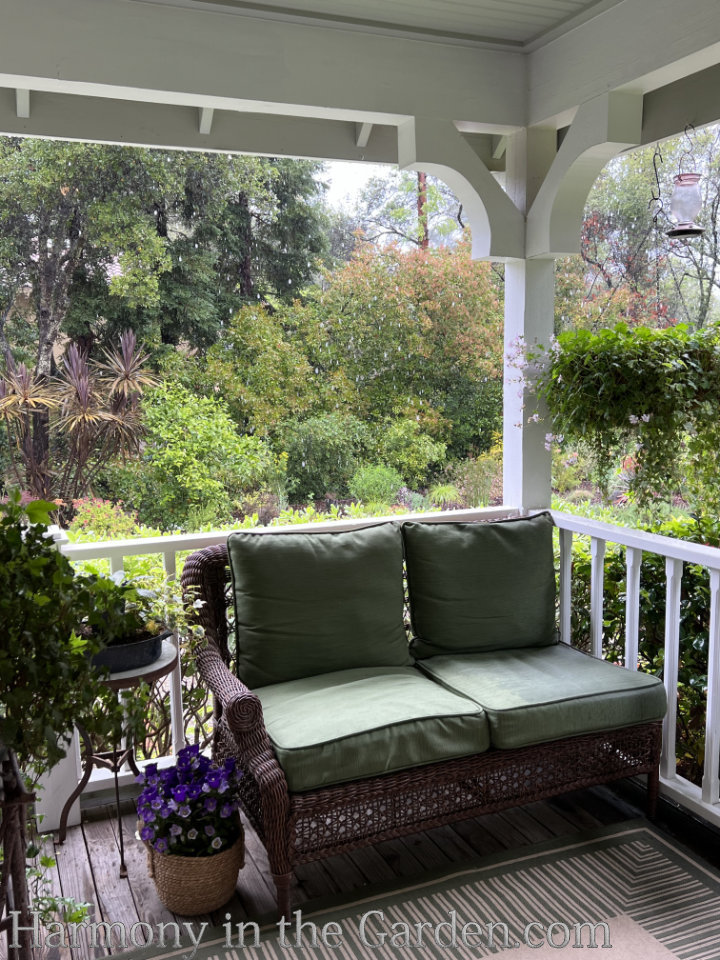
This area of the garden is visible from my favorite part of my house – the covered porch.
I spend as much time as I can on my porch (even in the rain) and love looking at my garden and all the wildlife that visits.
Therefore, the new rain garden needed to look good every day of the year, even in late winter/early spring.
Thanks to several early-blooming plants, I was able to create year-round color echoes.
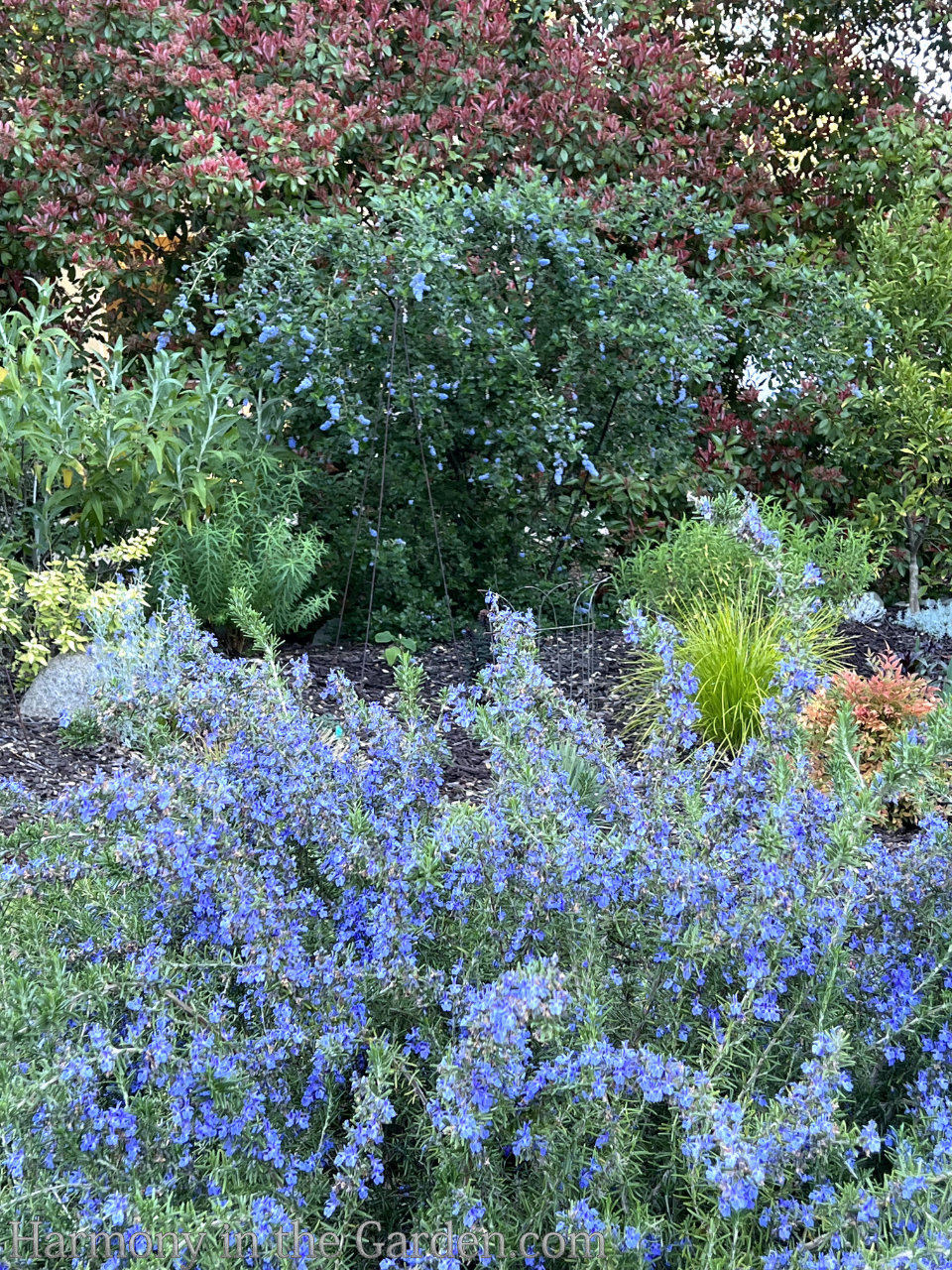
In early spring, an eye-popping blue color echo is created from the towering ceanothus ‘Ray Hartman’ and the lower-growing rosemary ‘Mozart.’
‘Mozart’ is a newer variety of rosemary which has quickly become my absolute favorite.
This mid-sized rosemary grows to just 2.5’x4′, making it ideal for the front or middle of the border.
‘Mozart’ has extra dark green foliage and is covered with the most electric, deep blue flowers of all the varieties I’ve seen (you can read about others that I use in my designs here.
It blooms for months at a time, taking a short break towards the end of summer, only to ramp up again in December.

I have a giant photinia hedge which divides my property from my neighbor’s. Starting in March, it begins producing its new season’s growth in gorgeous shades of garnet-red.
This red foliage lasts for two months (or more!), until reverting back to green.
Therefore, I took advantage of this early spring color to create a color echo that would highlight my beloved birdhouse (built by my good friend, Freeland Tanner.)
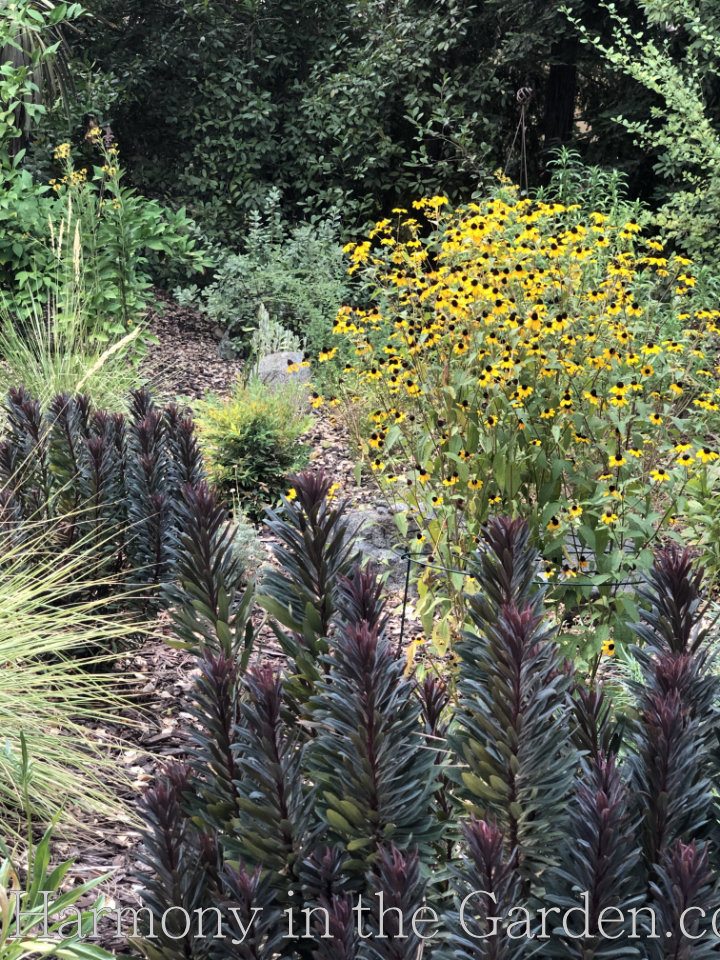
I have several euphorbia ‘Blackbirds’ planted throughout this area, providing deep, dark maroon foliage year-round.
I created a dark color-echo using the euphorbia’s dark foliage, with the nearby penstemon ‘Midnight Masquerade’ (that I featured above.)


I’ve also included plenty of evergreen plants to ensure the garden looks good year-round, with one of my favorites being the towering erica canaliculate ‘Rosea.’
The new raised berm (located behind the low ‘bowl’ outlined at the beginning of this article) creates super fast-draining soil.
This fast-draining soil is exactly what this evergreen, winter-blooming erica canaliculate ‘Rosea’ needs.
This variety of heather quickly grows to 10-feet (or more) and is covered with the cutest tiny pink flowers for months at a time.
And when the sun hits it just right, it literally glows in the garden.
Pardon me while I indulge in some amazing photos of this plant, but just LOOK below at how stunning this heather looks on a cold February morning!


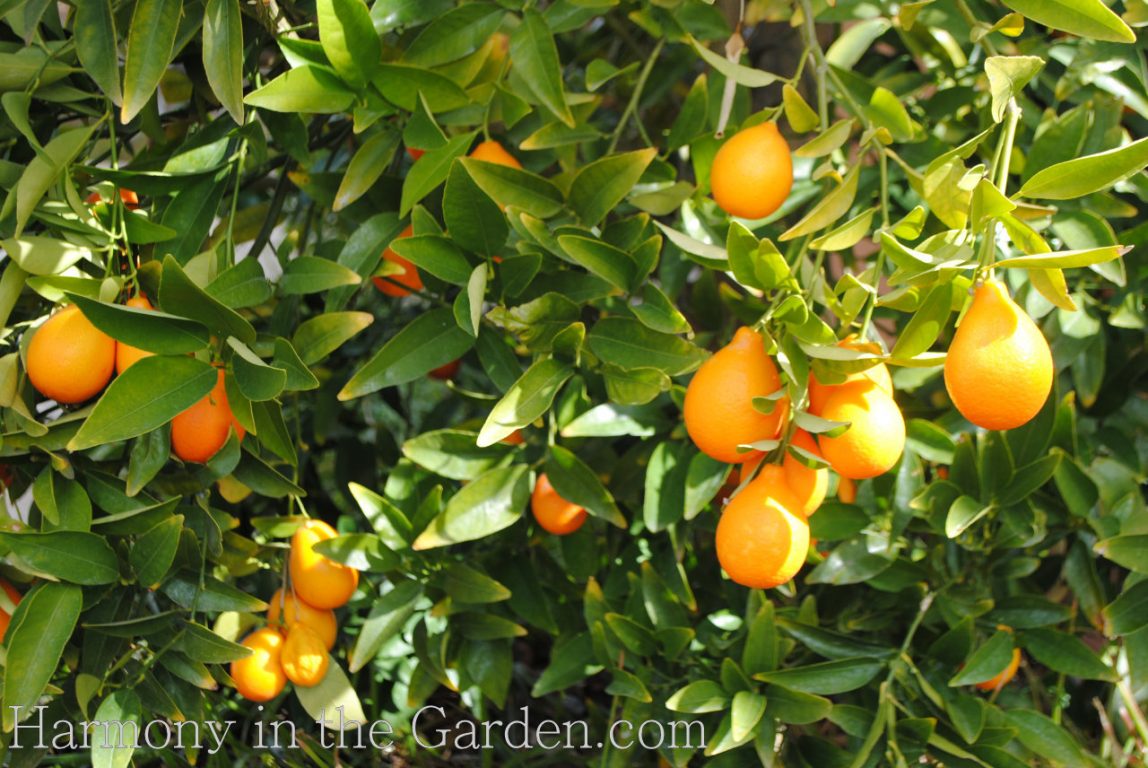
Also growing on top of the berm (where it has fast drainage) I planted three evergreen citrus trees:
– a Washington Navel orange, (which I LOVED in my previous garden)
– a Mandarinquat (which was a birthday present to my husband from my mother)
– and, a ‘Meyer’ lemon tree.
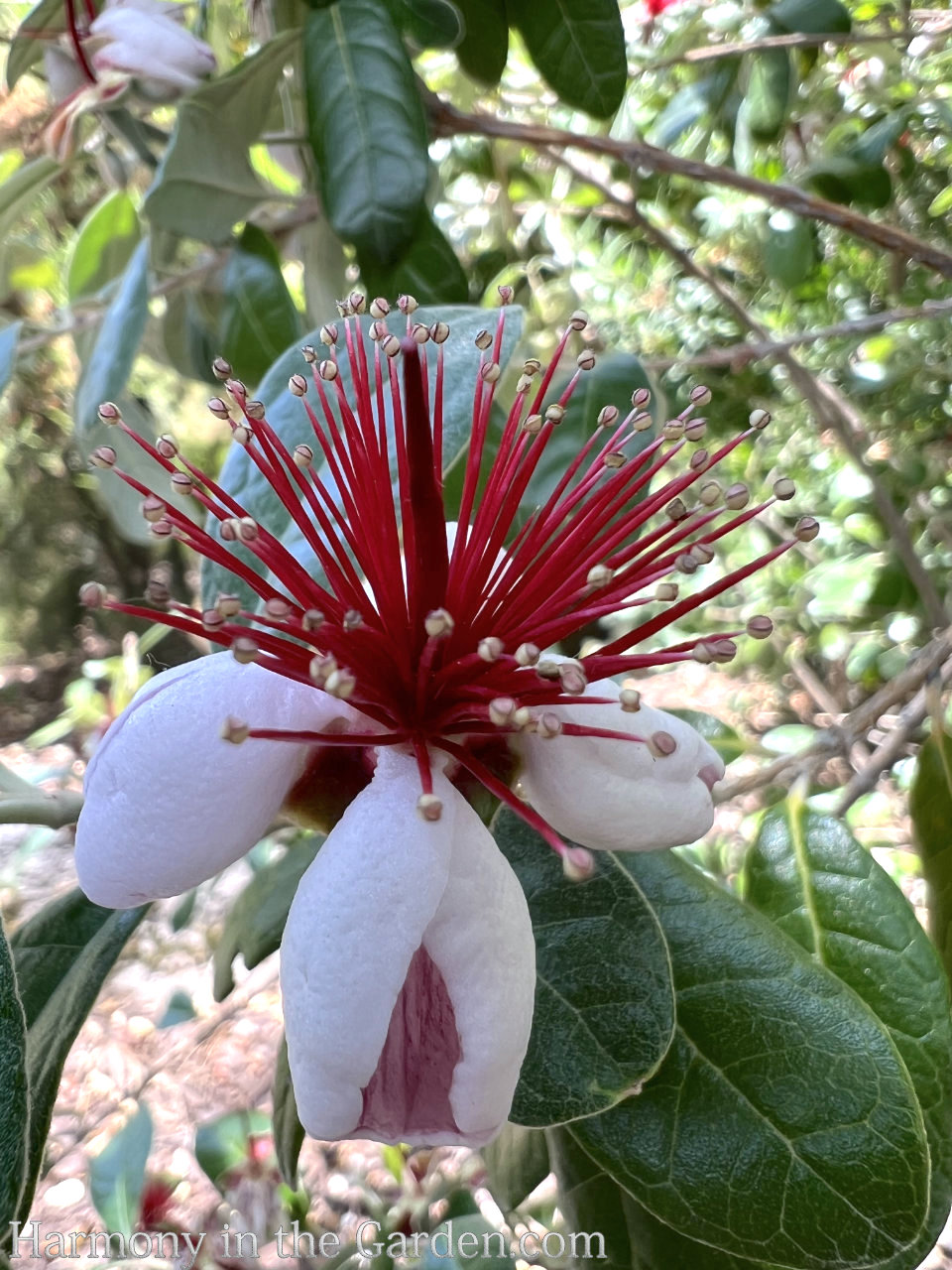
I also planted two Pineapple Guava trees (feijoa sellowiana.)
Grown as either shrubs or smaller trees, they have the most beautiful, soft gray-green foliage with edible red flowers, and delicious summer fruit.
Below is an example of the abundant fruit a single tree provides.
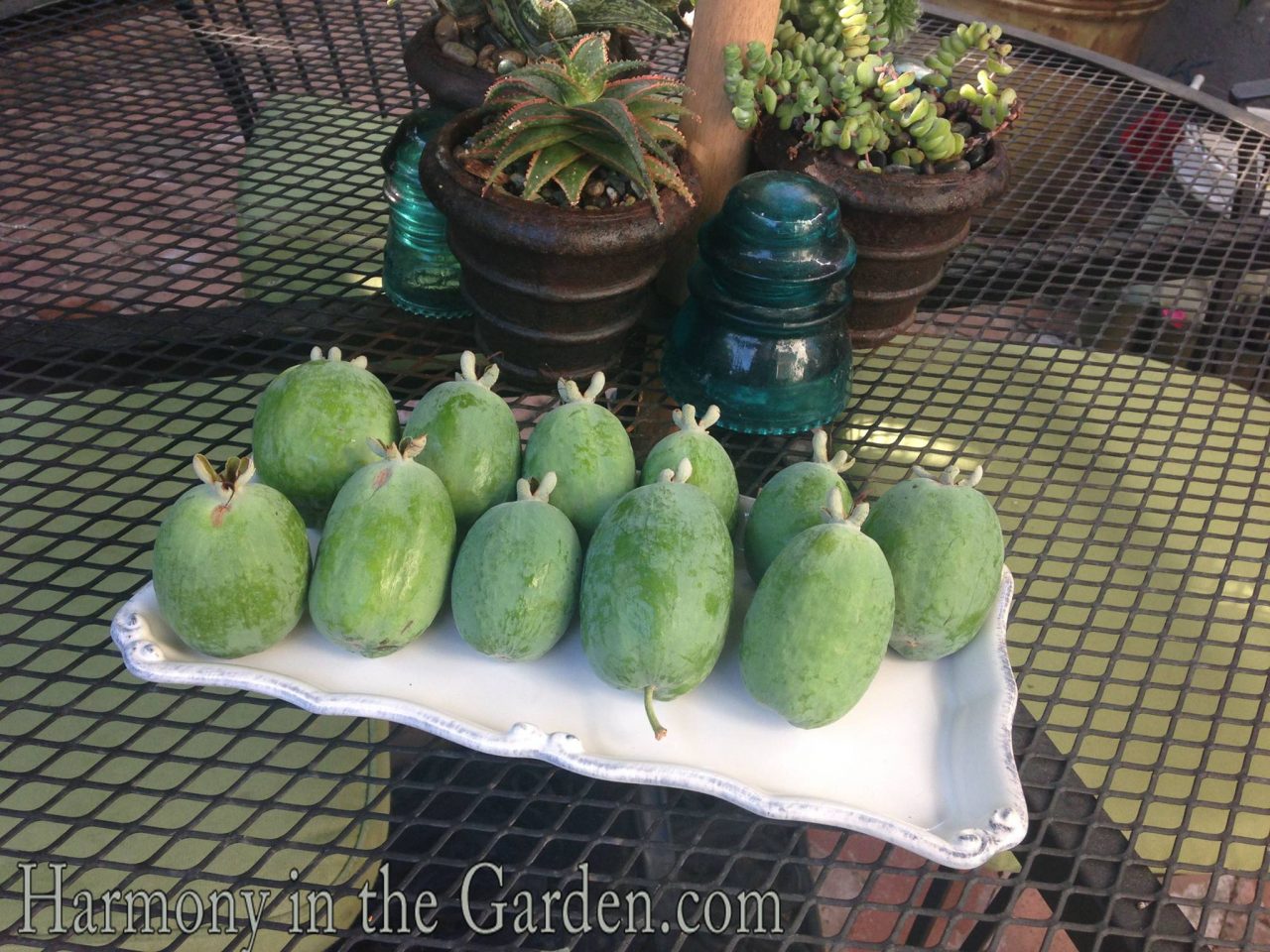
Objective #4
Create a year-round pollinator garden
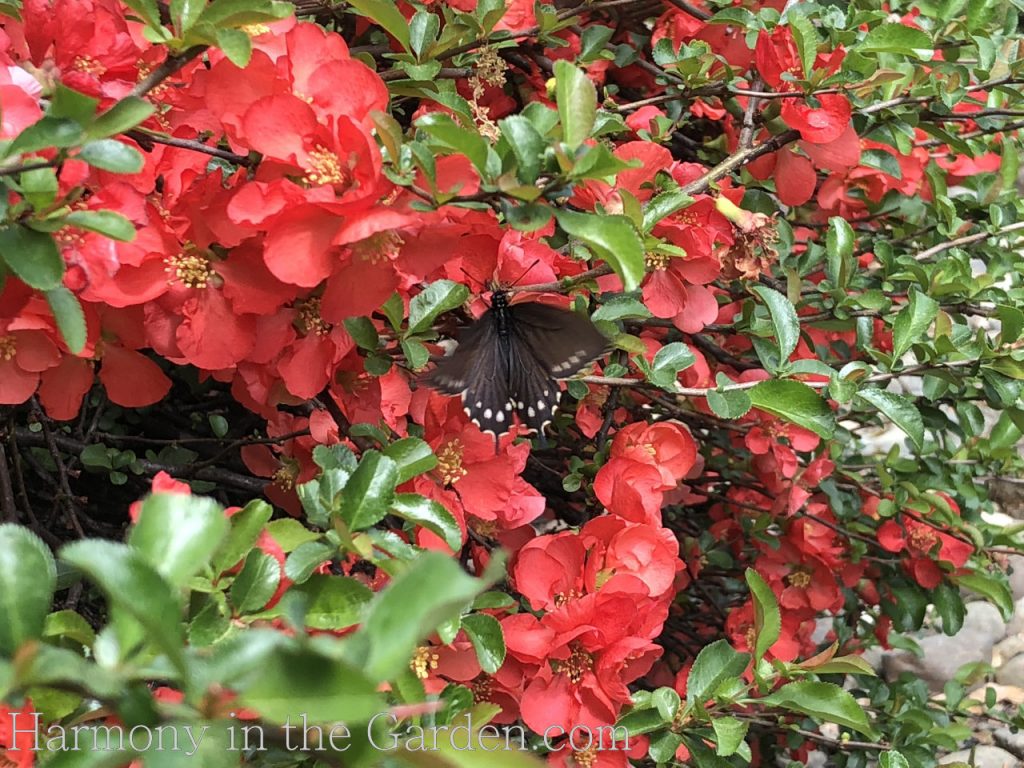
This is especially important in the late winter, as I wanted to provide nectar for our California Pipevine Swallowtail butterflies.
If we’ve had an unusually warm winter, these butterflies can appear as early as March 1st so I need to have something for them to eat!
Luckily, I have several existing quince shrubs that begin blooming in early February.
The butterflies absolutely swarm the quince flowers, appreciating the nectar source when not much else is blooming this time of year.
I have SO many more pollinator plants in this area to share with you – click here to read about them all.
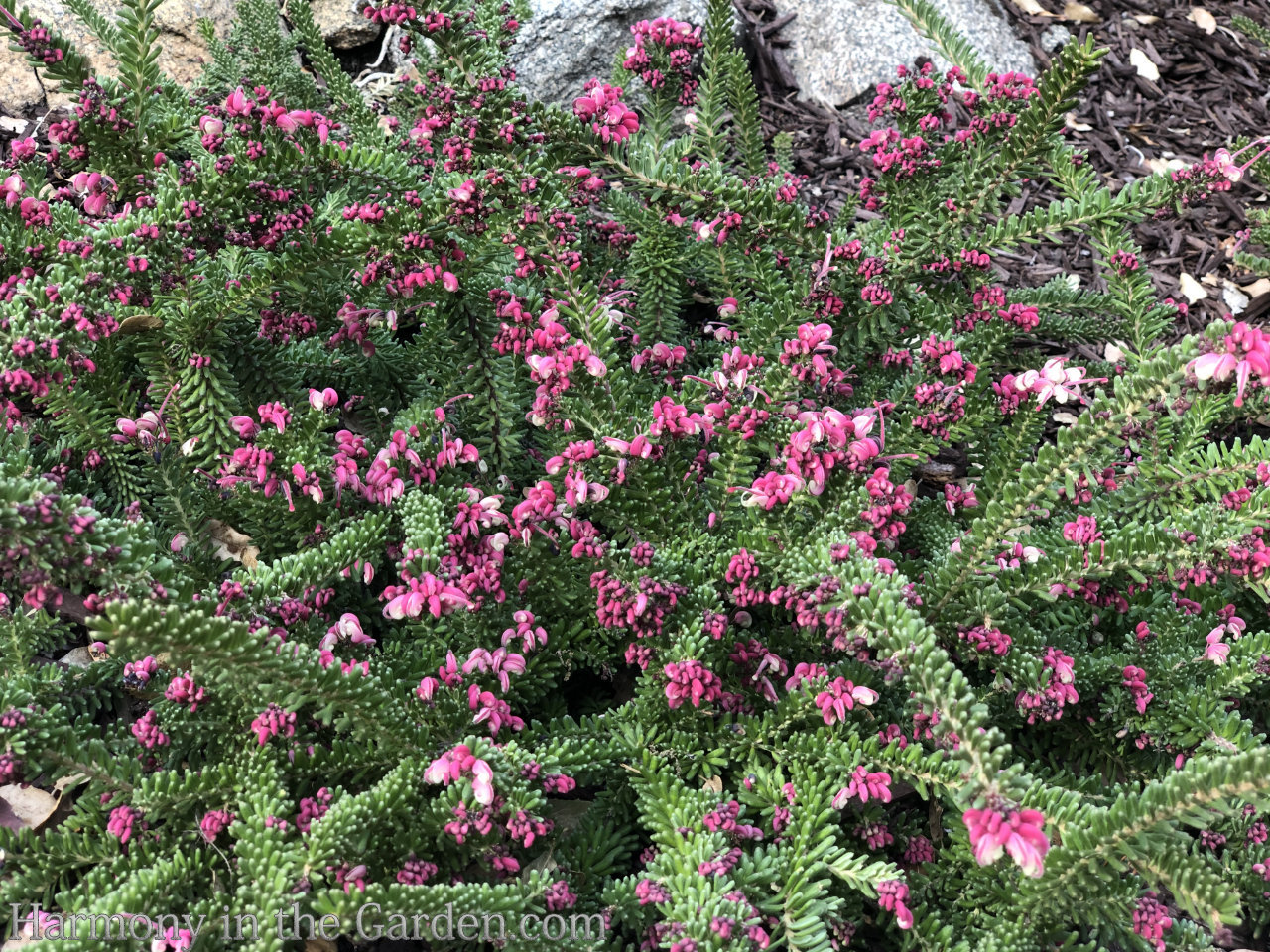
Of course I can’t forget to mention one of the longest-blooming winter plants in my garden – the evergreengroundcover grevillea ‘Mt. Tambooritha.’
Actually, these grevilleas have been blooming non-stop since October! (for more grevillea favorites, click here.)

It’s fitting that it’s pouring rain here today!
I do hope you’ve enjoyed touring my new rain garden, and if you’d like to see how it looks in the summer, click here (you’ll hardly recognize it!)
P.S. If you’d like to know more about creating your own rain garden/sunken garden/bioswale click here for a great article from Cornell University.






22 Comments
What uplifting, enticing ideas you have shared. Thank you for the detailed information on how to make a rain garden. Out of curiosity, what zone do you live in?
Thanks so much, Anna, I’m glad you enjoyed my post. I live in Northern California zone 9, where we get summers that are regularly in the triple digits with no summer rain and winter lows of about 30-32 degrees. We’re always coping with drought years which is why capturing every last drop of water is so important.
Thank you this step by step description of how to do a rain garden and your plant selection helps too!
You’re so welcome, Nevenka, I hope it helps!
Rebecca, lovely to see your garden and how it has been transformed. Guess we will be all appreciating our beautiful gardens since we are to ‘stay in place’. Spring is certainly transforming my garden.
Stay well-miss you
Hi Kathy, so nice to hear from you! I had hoped to come down your way this month and see if you’re free for a visit, but boy that sure didn’t happen! I’m hoping in May sometime and will definitely reach out to see if you’re available. I’d love to see you and your garden – it’s been a long time! Stay healthy! xoxo
Thank you for the online nursery suggestions. I miss going to the nursery and wandering around. This is the next best thing. All of your gardening ideas inspire me to get out there and get my hands dirty. Such a relief during these times.
Thank you again and you and your family stay well
You are so welcome, Linda, and I hope you find some treasures on these websites! I’ve found some of my very favorite plants from online nurseries – plants that would never be found at our local retail nurseries. Stay well!
Hello Rebecca,
Lovely to see your wonderful new garden and all the changes. Very inspiring. I recently planted quite a few of the grevillea ‘Mt. Tambooritha.’ in my front yard where I’ve removed the lawn. I do love them and look forward to watching them grow and spread. They seem like fantastic value.
Thanks again for sharing your garden with us. Stay well. 🙂
Hi Nancy – boy, your ears must’ve burning this morning! Amazing timing to hear from you! I was literally JUST telling my husband how much I LOVE the neroli blossom body oil I recently – I use it every day. We drove down to Los Altos for a super quick trip and I bought some more from Present (love those guys!) I hope you love the ‘Mt. Tam’s as much as I do. I have about 6 of them along the front of a border and they look good every day of the year, providing blooms for months on end. They’re definitely a fantastic value. Stay well, my friend!
Thank you Rebecca, that is an amazing transformation! Are there any butterfly pollinators that will work up here in Washington? I really enjoyed this post. Stay well.
Hi Gigi – yes, there’s a LOT of pollinators that would do well in your garden! I would take a look at the different quince varieties (there’s SO many colors and sizes available, and they like moisture which you have plenty of!!), ceanothus (again, lots of varieties – ‘Carmel Creeper’ is my favorite groundcover) – not sure if you get too cold for them, though, maybe Manzanita ‘Howard McMinn’ for your garden? And the ‘Mozart’ rosemary is my very favorite – a great mid-sized plant at 2′ x 4′. These are all late winter/early spring bloomers. I actually have a TON of pollinator plants in that part of my garden, but they’re not in bloom yet so I’ll be writing about them later this year. Send me pics of the new areas of your garden when you have them planted! 🙂
Dearest Rebecca,
Thank you so much for the inspiring photos of your transformation! And thank you for adding the red birdhouse to your garden! Take care of yourself and your family.
Much love to you, Sabrina
Thank you so much, Sabrina, it was so nice to finally put it up! We have the perfect spot for the big blue birdhouse, but the area needs work first before we can install it. I’m PRAYING we can get to it before the hot summer temps arrive! You and Freeland stay safe!!! xoxoxo
Thank you! It’s stunning. Question: Did you / will you set up any irrigation for the space?
Hi Patty – thanks for the compliment! Yes, we set up drip irrigation (if I didn’t, my garden would look like the ‘before’ pictures in no time!) In the dead of summer, with our blistering temps, I run the irrigation in this zone 2 times a week for about 15 minutes. Sometimes less, depending on how things are looking. I don’t really need to water this area for about 6 months out of the year, though, thanks to the super thick layer of bark. It’s at least 3″ thick and I’m truly floored at how moist the soil stays because of the insulation. We have 20+ oak trees on our property so I’m really careful not to overwater my garden.
What a lovely gift this Sunday morning, thank you Rebecca. I’m particularly enchanted with your penstemon ‘Midnight Masquerade’. The leaf color is luscious. I’m definitely going to check if it can survive in my low desert garden. My penstemons have been blooming nonstop for the last 6 weeks and our resident hummingbirds are constantly drunk with delight! Be safe my friend.
Hi Sheila – yes, that penstemon has been fantastic in my garden! I hope I can easily find more of them because it’s a winner. You stay safe, too!! xoxo
Good morning Rebecca and thank you so much for all the time and effort you put into your blog. It’s my favorite garden blog, and I always drop everything to read it. I have a question for you in response to your support of online nurseries. I’m a Master Gardener and love unusual varieties of plants, but I’ve had pretty pitiful luck with plants I’ve received from online nurseries. I’ve only had about 50% success, even with highly respected companies. Can you provide some guidance for ways to be more successful when ordering and receiving plants from online nurseries please? Thank you so much and take care of you and yours.
What a lovely thing to say, Shaun, you just made my morning. 🙂 I’m so sorry you’ve had such poor luck with online nurseries! I’ve been ordering online for years and years (sign of a true plantaholic, I suppose) since I want to try as many unique varieties as I can. I’d say I’ve had about a 90% success rate, with the biggest disaster coming from a big-name online nursery. That happened 2 years ago and it seemed like the person who packed the dozen or so little plants I had ordered was having a really bad day. Every single plant was just thrown in the box with no care given whatsoever, and when they arrived it was a complete mess with 80% of them destroyed/dead. I called and they gave me a complete refund, but will I order from them again? Nope. The nurseries I listed have always sent their plants to me with A LOT of care, plenty of packing, moist soil, detailed care instructions, etc. While the plants are usually super small, their root structures are typically healthy and I’m always pleasantly surprised at how quickly they become established in my garden. I recently ordered a few calluna ‘Firefly’ from Digging Dog and since their stock was unusually small, they sent me what they had and significantly reduced the price. I realize they can’t predict how quickly their stock will grow so I appreciate their attempt at doing their best. Same has happened with FBTS. When I receive the plants, I always give them a drink and let them rest a bit in their containers while getting used to their new environment (maybe for a 3 days or so) before planting them. I hope that helps a bit?
Thanks for my early morning garden fix. Always enjoy your enthusiasm for plants.
Still miss you in Los Altos,
Thank you, Susan, I appreciate it. 🙂